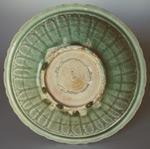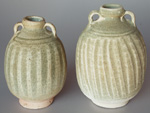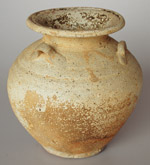
 The tubular support scar is only 6cm in
diameter - smaller than on the Longquan. Glaze
'drapery' around the footring indicates high-temperature firing.
The tubular support scar is only 6cm in
diameter - smaller than on the Longquan. Glaze
'drapery' around the footring indicates high-temperature firing.
| Discovering Asia's ceramic development |
 |
 The tubular support scar is only 6cm in
diameter - smaller than on the Longquan. Glaze
'drapery' around the footring indicates high-temperature firing.
The tubular support scar is only 6cm in
diameter - smaller than on the Longquan. Glaze
'drapery' around the footring indicates high-temperature firing.
|
 |
 Compare similar bowl from the Nanyang |
 |
 |
This wreck was discovered in 46 metres of water, 40 nautical miles from the coast. The site has been excavated, and more than 21,000 ceramic pieces recovered. These are mainly Sisatchanalai celadons of later character. A few Chinese and Vietnamese blue-and-white ceramics assisted in dating. The ship was about 28 metres long with a beam of 7-8 metres, and again of 'South China Sea' type. Hull planks and transverse bulkheads were joined with wooden dowels. Frames were fastened with bolts and nails. She was built from tropical hardwood of Hopea species.
The Royal Nanhai did not have any Sukhothai underglaze ware on board, even though the kilns must still have been in production. However, she carried very fine Sisatchanalai celadon, showing the technique, form and decoration of these kilns at their very best. Also on board were the precious items in a hidden compartment.
4,446 plates were recovered; 3,415 were intact. They were found stacked between bulkheads, with an average of 32 pieces in each stack. On the two plates (top left), note the foliated rims, carved after the application of a grey slip on the outer edge - which accents the bracket design, as do the incised lines. The glaze is thick and transparent. Decoration has now been added to the exterior of all celadon plates.
Large storage jars for the Royal Nanhai, such as that shown on the right,
came from Singburi (like the smaller jar on
the Nanyang, a type also seen
on the Royal Nanhai). They are quite different from the Singburi
jars seen on the later Xuande and Singtai sites. Large storage
jars on the earlier wrecks had come from Suphanburi, but the only Suphanburi
jars on the Royal Nanhai were smaller.

| Exhibition index |